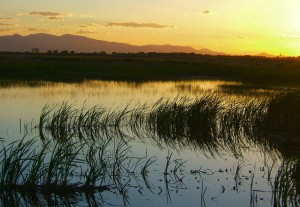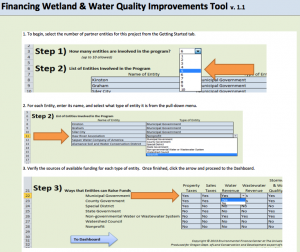 Local governments can be important partners for state and tribal wetland programs. As noted in a previous post, while states and tribes often manage wetland programs, local governments regularly make land use, zoning, and development decisions that have a direct impact on wetlands. Local governments are also involved more broadly in water quality issues, from watershed enhancements to stormwater programs to protecting their drinking water sources. But local governments need access to funding for wetland and water quality projects in order to be effective partners for states and tribes.
Local governments can be important partners for state and tribal wetland programs. As noted in a previous post, while states and tribes often manage wetland programs, local governments regularly make land use, zoning, and development decisions that have a direct impact on wetlands. Local governments are also involved more broadly in water quality issues, from watershed enhancements to stormwater programs to protecting their drinking water sources. But local governments need access to funding for wetland and water quality projects in order to be effective partners for states and tribes.
Certainly, as Dr. Jon Kusler suggests in the Association of State Wetland Managers’ guide, Protecting and Restoring Wetlands: Strengthening the Role of Local Governments, the federal government as well as states can provide funding to local governments for wetland projects. But the local governments themselves are capable of raising their own funds from myriad sources including taxes, fees, grants, and these sources often enjoy strong support from the electorate.
Beginning in 2012, the Environmental Finance Center provided comprehensive technical assistance to the state of Oregon on how the state could encourage local governments to preserve and protect wetlands, as part of the EFC’s Sustainable Finance for State and Tribal Wetland Programs project. We traveled to Oregon to conduct focus groups with local governments across the state to understand their attitude towards wetland protection and the barriers they face.
Many of the local governments in attendance expressed support for preserving wetlands and other key water quality features. Three main themes emerged from the discussions as potential barriers. First, many attendees felt that they did not have a strong understanding of how much money they could raise through various local government funding sources. Second, local governments in the room that had completed successful wetland projects in the past stressed that multiple funding sources were often necessary to pay for projects. And, third, because wetland and water quality features often do not line up well with political boundaries, successful projects often required a partnership amongst several governmental and non-governmental entities.
 Based on this feedback, the EFC developed a new spreadsheet tool that will help local governments and their partners understand how to finance wetland and water quality projects. This easy-to-use revenue tool allows anywhere from one to 10 separate governments, non-profits, or other entities looking to partner together on wetland and water quality projects to estimate how much money they can raise from various sources including changes to property taxes, sales taxes, water and wastewater fees, stormwater fees, flood control zone fees, permit fees, grants, and other sources. All of the revenue options are currently in use by actual local government programs across the country.
Based on this feedback, the EFC developed a new spreadsheet tool that will help local governments and their partners understand how to finance wetland and water quality projects. This easy-to-use revenue tool allows anywhere from one to 10 separate governments, non-profits, or other entities looking to partner together on wetland and water quality projects to estimate how much money they can raise from various sources including changes to property taxes, sales taxes, water and wastewater fees, stormwater fees, flood control zone fees, permit fees, grants, and other sources. All of the revenue options are currently in use by actual local government programs across the country.
Partners can determine if they can raise enough revenue for a specific project by entering a target revenue level and trying multiple scenarios of the various revenue sources. Also, partners can just enter revenue scenarios to determine how much money they could raise in order to choose a project of the appropriate size and scope. The tool is also intended to be used by state and tribal program personnel to help spur productive conversations with local governments about expanding their wetland activities.
Ultimately, the tool can help local governments address the potential barriers to wetland projects in an objective manner.





Leave a Reply